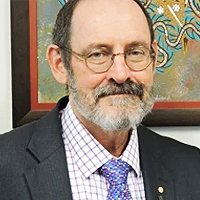Intravenous leiomyomatosis of the uterus: still discovered on anatomopathological examination
Published on: 2nd September, 2022
Background: Leiomyomas beyond the uterus are defined by benign smooth muscle cell tumors outside of the uterus. Intravenous leiomyomatosis is a rare type of uterine leiomyoma and is characterized by the formation and growth of benign leiomyoma tissue within the vascular wall. Herein, we present a case of Intravenous leiomyomatosis successfully treated by surgical removal and a review of actual medical recommendations.Case presentation: A 49 - year-old woman, maghrébin, G3 P2, no family history of uterine myomas mentioned, having systemic arterial hypertension, presented to our department with hypogastric pain and abnormal uterine bleeding in the prior five months resulting in anemia which required iron supplementation. On physical examination the vital signs were normal. A palpable mass in the hypogastrium was noted. The rest of the exam was unremarkable. Pelvic ultrasound showed a huge uterus with multiple heterogeneous leiomyomas, including at least one intracavity. Computed tomography scans and magnetic resonance imaging were not done initially due to the unaffordability of the patient. The initial diagnosis was leiomyoma. The decision to perform a total abdominal hysterectomy and bilateral salpingo-oophorectomy was taken. The abdomen was opened by a midline vertical incision. During surgery, multiple subserosal, intramural and submucosal fibroids ranging from 2 cm × 3 cm to 10 cm × 10 cm were seen. On pathological examination, the uterus measured 19 cm in the largest diameter and weighed 1.3 kg. The cut section showed white nodular myometrial masses. Microscopically, intravascular growth of benign smooth muscle cells is found within venous channels lined by endothelium. The diagnosis of Intravenous leiomyomatosis of the uterus without malignant transformation was retained. The patient was monitored for 14 months and subsequent computed tomography did not reveal any evidence of tumor recurrence. The follow-up will be performed annually till the age of menopause.Conclusion: Intravenous leiomyomatosis is a benign, rare and potentially lethal pathology. It especially affects premenopausal women with a history of uterine myoma, whether operated on or not. They require close and prolonged follow-up because of the high risk of recurrence.
Outcome of liver transplantation for autoimmune hepatitis in South Africa
Published on: 31st December, 2022
Background: Liver Transplantation (LT) is the definitive treatment for Autoimmune Hepatitis (AIH) in patients with decompensated cirrhosis, liver failure and hepatocellular carcinoma. Outcomes of LT in AIH among black-Africans are not well-defined. We performed a single-center retrospective-review of adult LT patients. The study period was from 1st August 2004-31st August 2019. The primary aim was to document 1- & 5- year patient and graft survival. A secondary aim was to compare the survival of black-Africans to Caucasians. Data was analyzed using survival-analysis. Results: A total of 56 LT were performed for AIH. Sixty-seven percent (n = 38/56) had confirmed AIH on explant histology. Of these, the majority i.e., 79% (30/38) were female and 21% (8/38) were male. There were equal numbers of black-African 42% (n = 16/38) and Caucasian 42% (n = 16/38) patients. Rejection was four-times higher in black-Africans as compared to Caucasians. Forty-four percent (n = 17/38) had an acute rejection episode and 13% (5/38) had chronic rejection. Recurrence was found in four black-African females. Post-LT patient survival at 1- and 5- years was 86.5% and 80.7%, and graft survival was 94% and 70.8% respectively. The 5- year patient survival was insignificantly lower for black-Africans (73.9%) as compared to Caucasians (83.7%) (p - value 0.26, CI 6.3 - 12.2). Five-year graft survival was significantly lower among black-Africans (55%) as compared to Caucasians (84.8%) (p - value 0.003 CI 3.8 - 8.1)Conclusion: Black-Africans had a four-fold higher rate of rejection compared to Caucasians. Recurrent AIH was only found in patients of black ethnicity. Similar 1- & 5- year patient survival rates were observed between the two ethnicities. The 5-year graft survival among black-Africans was significantly lower than Caucasians.
Diagnostic accuracy of apparent diffusion coefficient (ADC) in differentiating low- and high-grade gliomas, taking histopathology as the gold standard
Published on: 10th April, 2023
Gliomas are known to be one of the most grievous malignant central nervous system (CNS) tumors and have a high mortality rate with a low survival rate severe disability and increase risk of recurrence. Aim of his study is to determine the diagnostic accuracy of apparent diffusion coefficient (ADC) in differentiating low-grade and high-grade gliomas, taking histopathology as the gold standard. It is a Cross-sectional validation study conducted at the Armed Forces Institute of Radiology and Imaging, (AFIRI) Rawalpindi, Pakistan from 28th February 2022 to 27th August 2022.Materials and methods: A total of 215 patients with focal brain lesions of age 25-65 years of either gender were included. Patients with a cardiac pacemaker, breastfeeding females, de-myelinating lesions and malignant infiltrates, and renal failure were excluded. Then diffusion-weighted magnetic resonance imaging was performed on each patient by using a 1.5 Tesla MR system. The area of greatest diffusion restriction (lowest ADC) within the solid tumor component was identified while avoiding areas of peritumoral edema. Results of ADC were interpreted by a consultant radiologist (at least 5 years of post-fellowship experience) for high or low-grade glioma. After this, each patient has undergone a biopsy in the concerned ward, and histopathology results were compared with ADC findings. Results: Overall sensitivity, specificity, positive predictive value, negative predictive value, and diagnostic accuracy of apparent diffusion coefficient (ADC) in differentiating low- and high-grade gliomas, taking histopathology as the gold standard was 93.65%, 87.64%, 91.47%, 90.70% and 91.16% respectively. Conclusion: This study concluded that apparent diffusion coefficient (ADC) is the non-invasive modality of choice with high diagnostic accuracy in differentiating low- and high-grade gliomas.
Multiparametric MRI for the Assessment of Treatment Effect and Tumor Recurrence in Soft-tissue Sarcoma of the Extremities
Published on: 20th September, 2023
Soft-tissue sarcomas are a rare and complex group of malignant tumors. Advanced MRI sequences such as diffusion-weighted imaging (DWI) and perfusion-weighted imaging/dynamic contrast enhancement (PWI/DCE) can provide valuable tumor characterization and treatment response assessment. In the case of archetypical cellular tumors such as Pleomorphic Undifferentiated sarcoma (UPS), Good responders often display right-side displacement of the ADC intensity histogram, resulting in increased ADC-mean and decreased kurtosis and Skewness compared with Baseline and poor responders’ more left-sided curve. The PWI/DCE pattern most often associated with a good response is the presence of a “capsular-like” enhancement and a TIC type 2. Sarcoma hemorrhage patterns on SWI emerge during treatment, including “interstitial,” globular,” “luminal,” and incomplete and complete “peripheral ring-like” tumor wall hemosiderin impregnation. Treatment-induced bleeding is typically associated with low SWI-mean values and a left-sided intensity histogram with positive Skewness.During post-surgical surveillance, DCE MR imaging can reliably distinguish recurrent sarcoma from post-surgical scarring. TICs III, IV, and V raise the suspicion of local tumor recurrence, while TIC type II usually represents benign post-operative change such as granulation tissue. Advanced MRI is an essential tool for assessing sarcomas during and after therapy.
An Innovative Therapy by Changing the Gut Microbiome for the Dual Post-Operative Complications of the Recurrent Methicillin-Resistant Staphylococcus aureus (MRSA) Infections in the Residual Type II First Branchial Cyst and Facial Nerve Palsy
Published on: 20th December, 2023
A very unusual, interesting, and challenging case of a 24-year-old female who was born with three openings in the neck. The patient had chronic abdominal gaseous distention, recurrent abdominal pain, and constipation since early infancy. The patient presented in emergency with acute painful red, hot, and tender swelling in the left upper cervical area. Laboratory studies showed high inflammatory markers and a provisional diagnosis of abscess with a sinus was made. The patient underwent an emergency incision and drainage. Sinus recurred and a sinogram showed it to be a residual cyst in the left submandibular salivary gland. The total cyst excision was attempted with resultant recurrence and grade IV facial nerve palsy. Post-operatively recurrent infections caused by Methicillin-resistant Staphylococcus aureus (MRSA) required several courses of oral and intravenous broad-spectrum antibiotics with several hospital admissions with no resolution in sight. Subsequent ultrasound and magnetic resonance imaging showed a residual infected cyst, cutaneous sinus, and a fistula opening in the left ear canal. A diagnosis of branchial cyst type II of the first brachial cleft remnant with a fistula was established with bilateral branchial fistulas of the second branchial remnants and the associated colorectal hypoganglionosis based on radiological studies. The patient refused any further operative interventions. Therefore, the option of conservative treatment of hypoganglionosis with holobiotics consisting of prebiotics, probiotics and postbiotics, laxatives, dietary changes, lifestyle modifications, and dietary supplements started. All antibiotics were stopped. These therapies resulted in the resolution of residual first branchial remnants and recurrent MRSA infections with the improvement in the facial nerve palsy from grade V to grade III-IV together with an excellent cosmetic and functional result. The patient is doing well at follow-ups being infection-free for 18 months and repeat contrast-enhanced computed tomogram (CECT) has shown complete resolution of the residual cyst, sinus, and fistula with fibrosis.

HSPI: We're glad you're here. Please click "create a new Query" if you are a new visitor to our website and need further information from us.
If you are already a member of our network and need to keep track of any developments regarding a question you have already submitted, click "take me to my Query."
















